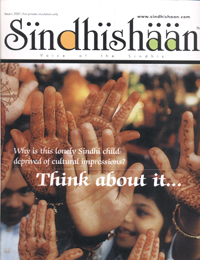AMERICAN INSTITUTE OF SINDHULOGY
Spreading the cult across seven seas
By Sreekanth R
Come to think of it! Pursuit’s belief, that the Indian culture is being tampered with by the western influence is countered by an analogous trend set by the westerners to adopt the ethnic Indian codes, and it might be something that we could effectively cash in on to promote our culture on a macro level. With a vast number of Indian citizens settling abroad, the numbers perennially multiplying over time, and with the foreigners taking keen interest in comprehending the rich and ancient Indian culture, it possibly would be an ideal promotional avenue for our cultural ethos. Sighting this vista and utilizing it for the valuable proposition of disseminating the ancient Indus civilization, which is traditionally believed to be the roots of Sindhi civilization is the American Institute of Sindhulogy.
It all started with the insightful thoughts of Shri Dial V Gidwani, who with the help and support of expatriate patrons in the United States of America ventured out to create an institution. It aims to enable the foreigners as well as Sindhi expatriates discover the copious culture and explore its beauty. Shri Gidwani originally from Sindh, mover over to Bombay for pursuing his studies and later in 1958 joined the Air India. The seeds of passion for reviving the cultural identity of Sindhi civilization were sown during his tenure with this company, which gave him the opportunity to move across the globe. “When I was posted in those foreign terrains, I found to my delight a Sindhi congregation celebrating Cheti Chand festival there,” recalls Shri Gidwani. After his numerous interactions with people of the community, he realised that the nearly inaudible voice of the cultural assets of the community were particularly because of the absence of a suitable platform. Bearing this in mind, he embarked on the monumental task of setting up an institution that would bring to light the Indus valley and Saraswati civilization’s history in the foreign lands. When questioned about his move to settle in the west and start such a movement there instead of his homeland, he retorts, “Even in America, there are a lot of Sindhi expatriates who are unaware of their tradition and legacy. The academic environment here is conducive to research and there are a lot of American students who are actively working on projects related to the Indus civilization, which undoubtedly is one of the most ancient and organized civilization discovered by mankind.” The Sindhi spirit is nonetheless an integral facet of this gentleman. “I am a Sindhi American now,” he announces, emphasizing that he is a Sindhi first and will always like to be one. And through the American Institute of Sindhulogy he endeavours to keep the light of Sindh burning.
The American Institute of Sindhulogy was inaugurated in August 2000 under the aegis of the Honourable Shri Ram Jethmalani and Shri Bhagwan Gidwani. Half a year since its inception, the institute is now relentlessly working in the direction of achieving its objectives. The efforts have been well received by the community and the American academicians alike. The institute epitomizes the integrity of the community with Sindhi Hindus as well as Muslims coming together under one roof with a common goal.
The institute is now chalking out major plans to expand the reach of its activities across America. It has already written to the UNESCO for recognition and support. Shri Gidwani reveals the plans for the year 2001 and states that the institute intends to start off with the circulation of ‘Return of the Aryans’, considered as the equivalent of Bible in the Sindhi culture in all the leading libraries. It also plans to work closely with the American educational institutes and spread awareness about the Indus valley and Saraswati civilization at the grass root levels by introducing special courses in schools, “When an American will talk about the Indian culture, it will automatically entice the Sindhi expatriate to explore it, more out of embarrassment that a foreigner knows more about his community,” says Shri Gidwani. “I feel very positive about the prospect of the institutes succeeding in its objectives,” he says. “But what we are now scouting for, are the funds that will help us do it better and more effectively,” he adds in the same breath.
Shri Dial V Gidwani on a short trip to India was collecting as much information and literature as he could about the Indus civilization which he hopes to circulate in the libraries in the US. His conversation is intermittently interrupted by phone-calls from various Sindhi personalities with whom he is networking in the quest to get some useful insights for the institution. While narrating the history and the objectives of the institute, he also points out an interesting aspect of the institute, in that, the institute has been purposely Sindhulogy spelt with a ‘U’ instead of ‘O’, which he substantiates saying that traditionally it is the Sindhu rivers from where the civilization originated and hence the chosen nomenclature which is a shift from the conventional way of naming.


